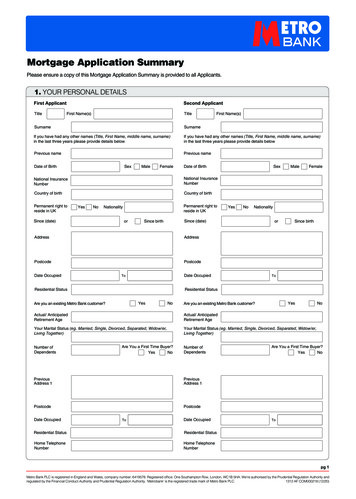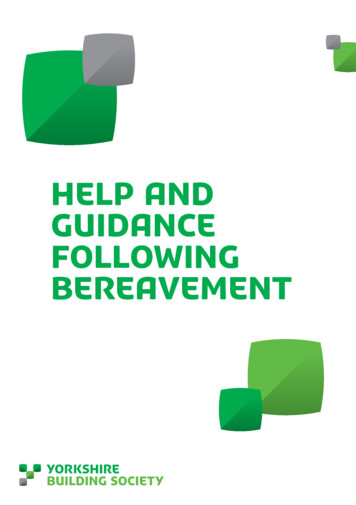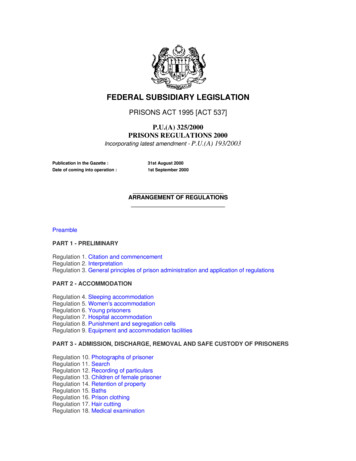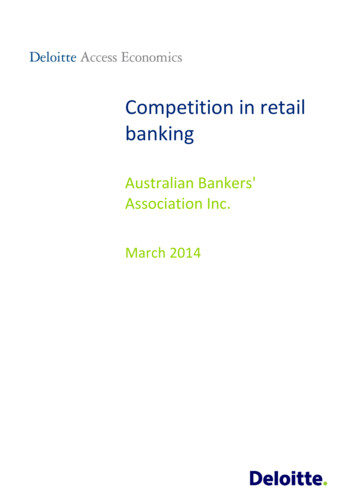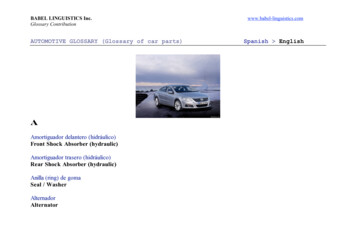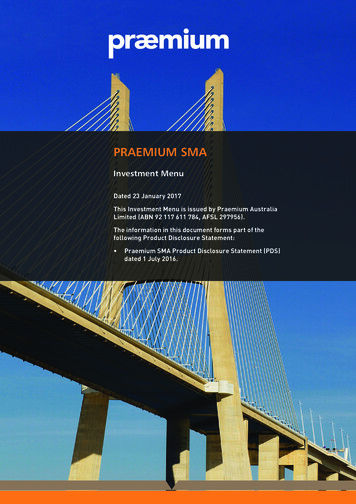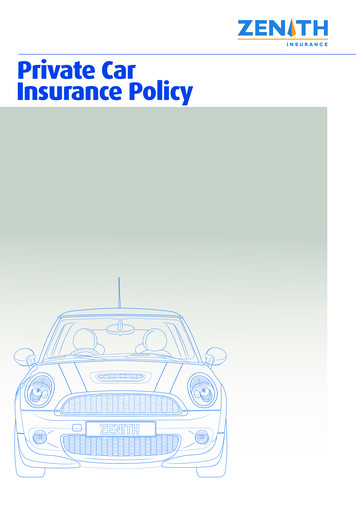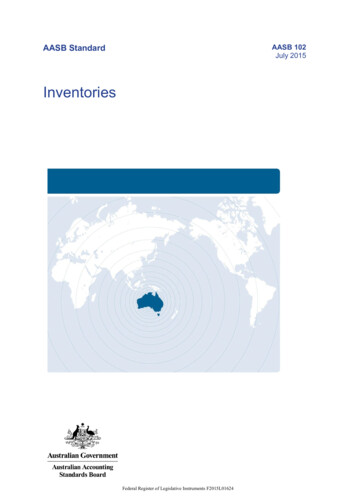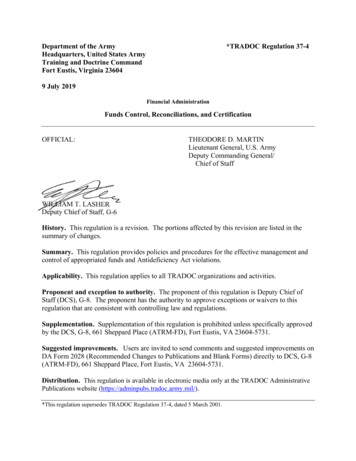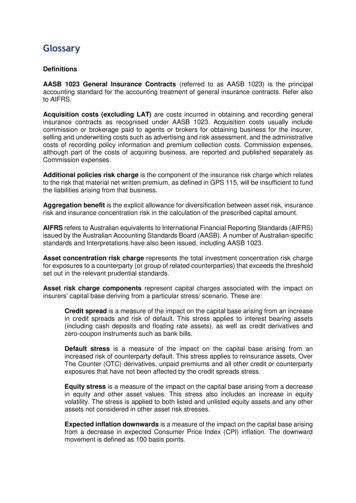
Transcription
GlossaryDefinitionsAASB 1023 General Insurance Contracts (referred to as AASB 1023) is the principalaccounting standard for the accounting treatment of general insurance contracts. Refer alsoto AIFRS.Acquisition costs (excluding LAT) are costs incurred in obtaining and recording generalinsurance contracts as recognised under AASB 1023. Acquisition costs usually includecommission or brokerage paid to agents or brokers for obtaining business for the insurer,selling and underwriting costs such as advertising and risk assessment, and the administrativecosts of recording policy information and premium collection costs. Commission expenses,although part of the costs of acquiring business, are reported and published separately asCommission expenses.Additional policies risk charge is the component of the insurance risk charge which relatesto the risk that material net written premium, as defined in GPS 115, will be insufficient to fundthe liabilities arising from that business.Aggregation benefit is the explicit allowance for diversification between asset risk, insurancerisk and insurance concentration risk in the calculation of the prescribed capital amount.AIFRS refers to Australian equivalents to International Financial Reporting Standards (AIFRS)issued by the Australian Accounting Standards Board (AASB). A number of Australian-specificstandards and Interpretations have also been issued, including AASB 1023.Asset concentration risk charge represents the total investment concentration risk chargefor exposures to a counterparty (or group of related counterparties) that exceeds the thresholdset out in the relevant prudential standards.Asset risk charge components represent capital charges associated with the impact oninsurers' capital base deriving from a particular stress/ scenario. These are:Credit spread is a measure of the impact on the capital base arising from an increasein credit spreads and risk of default. This stress applies to interest bearing assets(including cash deposits and floating rate assets), as well as credit derivatives andzero-coupon instruments such as bank bills.Default stress is a measure of the impact on the capital base arising from anincreased risk of counterparty default. This stress applies to reinsurance assets, OverThe Counter (OTC) derivatives, unpaid premiums and all other credit or counterpartyexposures that have not been affected by the credit spreads stress.Equity stress is a measure of the impact on the capital base arising from a decreasein equity and other asset values. This stress also includes an increase in equityvolatility. The stress is applied to both listed and unlisted equity assets and any otherassets not considered in other asset risk stresses.Expected inflation downwards is a measure of the impact on the capital base arisingfrom a decrease in expected Consumer Price Index (CPI) inflation. The downwardmovement is defined as 100 basis points.
Expected inflation upwards is a measure of the impact on the capital base arisingfrom an increase in expected Consumer Price Index (CPI) inflation. The upwardmovement is defined as 125 basis points.Foreign exchange downwards is a measure of the impact on the capital base arisingfrom a decrease in foreign currency exchange rates. The decrease is defined as 25per cent in the value of the Australian dollar against all currencies.Foreign exchange upwards is a measure of the impact on the capital base arisingfrom an increase in foreign currency exchange rates. The upward movement is definedas 25 per cent in the value of the Australian dollar against all foreign currencies.Property stress is a measure of the impact on the capital base arising from changesin property and infrastructure asset values.Real interest rate downwards is a measure of the impact on the capital base arisingfrom a decrease in real interest rates. The downward movement is defined as 0.2 timesthe nominal risk free interest rate, to a maximum of 200 basis points.Real interest rate upwards is a measure of the impact on the capital base arisingfrom an increase in real interest rates. The upward movement is defined as 0.25 timesthe nominal risk free interest rate, to a maximum of 200 basis points.Impact of diversification and tax benefits is the explicit allowance for diversificationbetween asset classes in the calculation of the asset risk charge. This includes any taxbenefits resulting from the asset risk charge stresses.Asset risk charge is the minimum amount of capital required to be held against asset risks.The asset risk charge relates to the risk of adverse movements in the value of a reportinginsurer’s on-balance sheet and off-balance sheet exposures.Australian business is any general insurance business carried on in Australia by a level 1insurer within a level 2 group.Average asset items are the average of the opening and closing balances of the relevantitem over the period.Branch insurer is the Australian branch of a foreign insurer/reinsurer. It is not locallyincorporated.Captive insurer is a company within a group of related companies performing the function ofinsurer to that group. Captive insurer is a company within a group of related companiesperforming the function of insurer to that group.Cession ratio (prospective) is Outwards reinsurance expense (prospective) divided byGross written premium.Cession ratio is Outwards reinsurance expense divided by Gross earned premium.Commercial line insurers are direct insurers that primarily sell commercial lines business.Commercial lines are insurance products primarily sold to commercial customers. Thistypically includes commercial motor vehicle, fire and industrial special risks, professionalindemnity, public and product liability, employers' liability and aviation classes of business.
Commission expense is the commission or brokerage paid to agents or brokers for obtainingbusiness for the insurer.Commission revenue is the commission revenue received in relation to the insurancebusiness, and is reported in accordance with the pattern in which it is earned.Common equity tier 1 capital is the highest quality component of capital held by the insureras determined under the eligibility characteristics set out in Prudential Standard GPS 112Capital Adequacy: Measurement of Capital, net of all regulatory adjustments.Current and prior years’ components of claims or recoveries relate to those incurred overthe current year and movements in provisions for past years. This component is now reportedon an AASB 1023 basis. Prior to September 2010, it was reported on a GPS 310 basis.Current period net claims expense refers to payments and provisions from the current yearrelating to accidents occurring in that year. They are reported on an undiscounted and centralestimate basis.Deferred acquisition costs are the deferred portion of acquisition costs under AASB 1023,amortised in accordance with the expected pattern of the risk of the related general insurancecontracts.Deferred reinsurance expense represents the amount of reinsurance expense which iscapitalised as an asset in accordance with the expected pattern of the risk of the relatedgeneral insurance contracts.Direct insurers are those insurers who predominantly undertake liability by way of directinsurance business.Direct insurers from large groups are direct insurers in an insurance group, where theinsurers in the group collectively make up at least ten per cent of industry gross earnedpremium.Eligible capital base represents the total eligible capital base of the insurer. A general insurermust, at all times, maintain a capital base in excess of its Minimum Capital Requirement. Forbranch insurers, capital base is represented by Net assets in Australia.Fire service levy is the fire service levy (and other levies imposed by state and territorygovernments) which is part of Gross earned premium.GPS 310 refers to Prudential Standard GPS 310 Audit and Actuarial Reporting and Valuation.GPS 320 refers to Prudential Standard GPS 320 Audit and Actuarial Reporting and Valuation.Gross earned premium is the earned premium revenue relating to direct business andinwards reinsurance plus Fire service levy and measured on an AASB 1023 basis.Gross incurred claims (current and prior years) comprises paid claims during the periodand movements in outstanding claims liability from both direct business and inwardsreinsurance.Gross loss ratio is the Gross incurred claims (current and prior years) (net of non-reinsurancerecoveries revenue) divided by Gross earned premium.
Gross written premium is recognised fully when the business is written. Prior to September2010, this was measured under APRA's prospective reporting framework. From September2010, this is measured in accordance with AASB 1023.Income tax expense (benefit) from continuing operations is the income tax expense(benefit) attributable to the profit (loss) from continuing operations for the relevant period.Income tax expense is reported in accordance with Australian Accounting Standard AASB 112Income Taxes (AASB 112).Insurance concentration risk charge is the minimum amount of capital required to be heldagainst insurance concentration risks. The insurance concentration risk charge relates to therisk of an adverse movement in the reporting insurer's capital base due to a single large lossor series of losses.Insurance result is the Underwriting result plus Net investment income on assets backinginsurance liabilities less investment expenses on assets backing insurance liabilities.Intangible assets refers to assets subject to AASB 138 'Intangible Assets'. This includesgoodwill associated with the acquisition of assets other than a controlled entity or subsidiary,impairment losses of goodwill and other intangible assets with an indefinite or finite life.Investment income from September 2010 onwards refers to Investment income onshareholders' funds plus investment income attributed to assets backing insurance liabilitiesless investment expenses relating to assets backing insurance liabilities.Investment income on shareholders' funds is the investment income on assets nototherwise allocated to support insurance liabilities.Listed direct equity holdings are equity securities held directly by the reporting insurer thatare listed on a recognised stock exchange.Listed subordinated debt refers to debt securities classified as subordinated which are listedon a recognised exchange.LMIs (Lenders mortgage insurers) provide cover to protect lenders from default byborrowers on loans secured by mortgage. LMI insurers are substantially different to otherinsurers and are subject to special conditions of authority.Net earned premium comprises Gross earned premium less Outwards reinsurance expense.Net incurred claims (current and prior years) is Gross incurred claims (current and prior years)net of Non-reinsurance recoveries revenue (current and prior years) and Reinsurancerecoveries revenue (current and prior years).Net investment income on assets backing insurance liabilities is the investment incomeattributed to assets backing insurance liabilities less investment expenses relating to assetsbacking insurance liabilities.Net loss ratio is Net incurred claims (current and prior years) divided by Net earned premium.Net profit/loss after tax refers to profit or loss from ordinary activities after income tax, beforeextraordinary items.Net U/W combined ratio is the Net incurred claims (current and prior years) plus Underwritingexpenses divided by Net earned premium.
Net written premium comprises Gross written premium less Outwards reinsurance expense(prospective).Non Branch insurer is an Australian incorporated insurer/reinsurer.Non-proportional reinsurance is reinsurance where the reinsurer pays losses only above anagreed retention/ deductible up to an agreed maximum limit.Non-recurring items that are part of net claims is the amount of Net incurred claims (currentand prior years) that is not included in Current period claims expense.Non-reinsurance recoverables comprise recoverables for current and prior years fromsubrogation, salvage, sharing arrangements etc, net of provision for doubtful debts andincludes input tax credits (from March 2007 onwards due to revised general insurancereporting forms).Non-reinsurance recoverables on premium liabilities comprise expected recoverables forfuture years from subrogation, salvage, sharing arrangements etc, net of provision for doubtfuldebts and includes input tax credits (from March 2007 onwards due to revised generalinsurance reporting forms).Non-reinsurance recoveries revenue (current and prior years) comprises amounts theinsurer has recovered or is entitled to recover from subrogation, salvage and other nonreinsurance recoveries relating to current and prior years.Number of risks written is the number of risks written during the relevant period for directbusiness only. Where a policy covers multiple APRA classes of business and the premium isapportioned between these classes, one risk is reported in each APRA class of business towhich premium was allocated. For example, a home and contents policy with a domesticliability component has premium allocated to both the householders class of business, andthe public liability class of business. For this policy, one risk will be reported for thehouseholders class of business, and one risk will be reported for the public liability class ofbusiness.Offshore business relates to insurers' income/expenses that are on risk, assets that areinvested and liabilities that are located outside of Australia. Offshore business relates toinsurers' income/expenses that are on risk, assets that are invested and liabilities that arelocated outside of Australia.Operational risk charge is the minimum amount of capital required to be held againstoperational risks. The operational risk charge relates to the risk of loss resulting frominadequate or failed internal processes, people and systems or from external events.Other assets comprises investment income receivable, other reinsurance assets receivablefrom reinsurers (i.e. other than reinsurance recoveries), GST receivable, other receivables,tax assets, plant and equipment (net of depreciation), derivative assets held at fair value (fromMarch 2007 onwards due to AIFRS) and other assets.Other direct insurers are direct insurers that are not part of a large group, and do notpredominantly write either personal lines, commercial lines or mortgage business.Other investments are strategic investments/acquisitions and other investments that do notconstitute investments integral to insurance operations.
Other items comprises other operating income and income tax expense or benefit (andgoodwill amortisation in periods prior to March 2007).Other liabilities comprises creditors and accruals, other provisions, derivative liabilities heldat fair value (from March 2007 onwards due to AIFRS) and other liabilities.Other operating expenses are all operating expenses not related to underwriting.Other profit and loss items refers to any profit and loss items not already defined in thispublication. Specifically, it is comprised of: bargain purchases immediately recognised in profitand loss; Profit(loss) from non-current assets and disposal groups classified as held for saleand not qualifying as discontinued operations.Other risk charges are asset concentration risk charge plus operational risk charge plusadjustment to prescribed capital amount as approved by APRA less aggregation benefit.Other underwriting expenses includes all other underwriting expenses which are not includedin Acquisition costs (excluding LAT) or Commission expenses and are subject to deferralunder AASB 1023.Outstanding claims liability is the insurer's liability for outstanding claims. It recognises thepotential cost to the insurer of settling claims which it has incurred at the reporting date(including estimates of claims that have not yet been notified to the insurer), but which havenot been paid. The amount reported is after taking account of inflation and discounting,without deducting reinsurance and non-reinsurance recoveries. Prior to September 2010,outstanding claims was reported under APRA's previous prospective reporting frameworkwhich required a minimum level of outstanding claims provision calculated in accordance withGPS 310. Since September 2010, Outstanding claims liability is reported on an AASB 1023basis, with any deficiency compared to amount calculated under a GPS 310 basis deductedfrom capital.Outwards reinsurance expense is the total outwards reinsurance expense relating to currentand prior years cover. Outwards reinsurance expense is recognised in accordance with thepattern of reinsurance service received as required by AASB 1023.Payables on reinsurance contracts comprise amounts payable to reinsurers. This includespremiums payable but not yet due for payment, deposits withheld from reinsurers,commissions due to reinsurers and the reinsurers' portion of recoveries and salvage.Personal line insurers are direct insurers that primarily sell personal lines business.Personal lines are insurance products primarily sold to private individuals. It typically includeshouseowners/householders, domestic motor vehicle, CTP motor vehicle, travel and consumercredit classes of business.Premium liabilities relate to the future claims arising from future events insured underexisting policies reported under APRA's previous prudential reporting framework. UnderAASB 1023, premiums to cover the cost related to future events are included in the conceptof Unearned premium liability. The amount reported is after taking account of inflation anddiscounting, without deducting reinsurance recoverables and non-reinsurance recoveries.Premium receivables are premiums due, net of provision for doubtful debts, includingunclosed business written close to the reporting date.
Prescribed capital amount is the minimum required level of capital for regulatory purposes,calculated under APRA's new capital framework which was effective from 1 January 2013.Prescribed capital amount will not necessarily equal the sum of all risk charges, as insurersare required to hold 5 million minimum capital.Proportional reinsurance is reinsurance where the reinsurer and reinsured share, inproportion, the premium and losses of the reinsured.Reinsurance recoverables comprise amounts recoverable for current and prior years underreinsurance contracts.Reinsurance recoverables From contracts ineligible under GPS 230 are any amountsdue to an insurer from a reinsurer that arise from the recognition of outstanding claimsliabilities, where the reinsurance arrangement does not meet the reinsurance document testor governing law requirements detailed in GPS 230 Reinsurance Management .Reinsurance recoverables on premium liabilities comprise expected amounts recoverablefor future years under reinsurance contracts.Reinsurance recoverables Overdue for more than 6 months are any amounts due to aninsurer from a reinsurer that arise from the recognition of outstanding claims liabilities wherereceivables are overdue for more than six months since a request for payment was made tothe reinsurer and where there is no formal dispute between the insurer and reinsurer in relationto the receivables.Reinsurance recoverables related to events that occurred prior to the insurer'sprevious financial year are any amounts due to an insurer from a reinsurer that arise fromthe recognition of outstanding claims liabilities in the insurer's previous financial year.Reinsurance recoverables related to events that occurred within the insurer's currentand previous financial years are any amounts due to an insurer from a reinsurer that arisefrom the recognition of outstanding claims liabilities in the insurer's current and previousfinancial years.Reinsurance recoveries revenue (current and prior years) comprises amounts the insurerhas recovered or is entitled to recover from reinsurers on incurred claims relating to currentand prior years during the reporting period.Reinsurers are those insurers who, excluding intra-group arrangements, predominantlyundertake liability by way of reinsurance business.Results of liability adequacy tests refers to any adjustments to deferred acquisition costsor the unexpired risk liability as a result of performing the liability adequacy tests in accordancewith AASB 1023.Return on net assets is net profit/loss divided by the average net assets for the period. SeeReturns.Return on total assets is net profit/loss divided by the average on-balance sheet total assetsfor the period. See Returns.Return on total investments is investment income divided by the average total investmentsfor the period. See Returns.
Returns are expressed as annual percentage rates. For quarterly returns this is achieved bymultiplying the rate, calculated using the formulae specified, by 4. For returns relating tofinancial/calendar years, this is achieved by using the full year income/profit and averageasset/equity figures to calculate the rate.Run-off insurers are restricted by APRA from writing new or renewal insurance business.However, the company may still be acting as an insurance agent, broker or underwriting agentfor other general insurers.Securities issued by financial corporations are bank accepted bills, commercial paper,promissory notes and long term debt securities issued by ADIs, general insurers andsecuritisers.Securities issued by government and government corporations are commercial paper,promissory notes and long term debt securities issued by the Australian CommonwealthGovernment, Australian Commonwealth Government corporations, and state, territory andlocal government.Tier 1 capital is the second-highest quality component of capital held by the insurer.Tier 2 capital is the third-highest quality component of capital held by the insurer.Trust distributions are distributions by trusts received by the reporting insurer during therelevant period.U/W expense ratio (prospective) is Underwriting expenses divided by Net written premium.U/W expense ratio is Underwriting expenses divided by Net earned premium.Unlisted subordinated debt refers to debt securities classified as subordinated which arenot listed on a recognised exchange.Unlisted direct equity holdings are equity securities held directly by the reporting insurerthat are not listed on a recognised stock exchange.Underwriting expenses are expenses incurred as a result of underwriting activities: i.e.acquisition costs plus levies and charges plus other underwriting expenses not includingoutwards reinsurance expense less commission revenue.Underwriting result is net premium revenue less net incurred claims and underwritingexpenses.Unearned premium liability represents the component of premium revenue that is unearned.Premium should be earned in accordance with the pattern of risk expected under the generalinsurance contract under AASB 1023.Unexpired risk liability is recognised in accordance with AASB 1023 as a result of liabilityadequacy test failures.Unrealised gains/ losses refers to any increases or decreases in the fair value of an assetwhere the asset has not been disposed of during the relevant period.
Net written premium comprises Gross written premium less Outwards reinsurance expense (prospective). Non Branch insurer is an Australian incorporated insurer/reinsurer. Non-proportional reinsurance is reinsurance where the reinsurer pays losses only above an agreed retention/ deductible up to an agreed maximum limit. Non-recurring items that are part of net claims is the amount of Net incurred .
